ATLAS experiment
 | |
| LHC experiments | |
|---|---|
| ATLAS | A Toroidal LHC Apparatus |
| CMS | Compact Muon Solenoid |
| LHCb | LHC-beauty |
| ALICE | A Large Ion Collider Experiment |
| TOTEM | Total Cross Section, Elastic Scattering and Diffraction Dissociation |
| LHCf | LHC-forward |
| MoEDAL | Monopole and Exotics Detector At the LHC |
| LHC preaccelerators | |
| p and Pb | Linear accelerators for protons (Linac 2) and Lead (Linac 3) |
| (not marked) | Proton Synchrotron Booster |
| PS | Proton Synchrotron |
| SPS | Super Proton Synchrotron |
Coordinates: 46°14′8″N 6°3′19″E / 46.23556°N 6.05528°E ATLAS (A Toroidal LHC ApparatuS)[1] is one of the seven particle detector experiments constructed at the Large Hadron Collider (LHC), a particle accelerator at CERN (the European Organization for Nuclear Research) in Switzerland. The experiment is designed to take advantage of the unprecedented energy available at the LHC and observe phenomena that involve highly massive particles which were not observable using earlier lower-energy accelerators. ATLAS was one of the two LHC experiments involved in the discovery of the Higgs boson in July 2012.[2][3] It was also designed to search for evidence of theories of particle physics beyond the Standard Model.
The ATLAS detector is 46 metres long, 25 metres in diameter, and weighs about 7,000 tonnes; it contains some 3000 km of cable.[4] The experiment is a collaboration involving roughly 3,000 physicists from over 175 institutions in 38 countries.[5] The project was led for the first 15 years by Peter Jenni, between 2009 and 2013 was headed by Fabiola Gianotti, from 2013 to 2017 by David Charlton, and afterwards by Karl Jakobs.[6]
History

The ATLAS Collaboration, the group of physicists who built and run the detector, was formed in 1992 when the proposed EAGLE (Experiment for Accurate Gamma, Lepton and Energy Measurements) and ASCOT (Apparatus with Super Conducting Toroids) collaborations merged their efforts to build a single, general-purpose particle detector for the Large Hadron Collider.[7] The design was a combination of the two previous experiments, and also benefitted from the detector research and development that had been done for the Superconducting Supercollider. The ATLAS experiment was proposed in its current form in 1994, and officially funded by the CERN member countries in 1995. Additional countries, universities, and laboratories have joined in subsequent years. Construction work began at individual institutions, with detector components then being shipped to CERN and assembled in the ATLAS experiment pit starting in 2003.
Construction was completed in 2008 and the experiment detected its first single beam events on 10 September of that year.[8] Data taking was then interrupted for over a year due to an LHC magnet quench incident. On 23 November 2009, the first proton-proton collisions occurred at the LHC and were recorded by ATLAS, at a relatively low injection energy of 450 GeV per beam. Since then, the LHC energy has been increasing: 900 GeV per beam at the end of 2009, 3,500 GeV for the whole of 2010 and 2011, then 4,000 GeV per beam in 2012. After a long shutdown in 2013 and 2014, in 2015 ATLAS saw 6,500 GeV per beam.[9][10][11]
Background

The first cyclotron, an early type of particle accelerator, was built by Ernest O. Lawrence in 1931, with a radius of just a few centimetres and a particle energy of 1 megaelectronvolt (MeV). Since then, accelerators have grown enormously in the quest to produce new particles of greater and greater mass. As accelerators have grown, so too has the list of known particles that they might be used to investigate. The most comprehensive model of particle interactions available today is known as the Standard Model of Particle Physics.
With the important exception of the Higgs boson, now detected by the ATLAS and the CMS experiments,[12] all of the particles predicted by the model had been observed by previous experiments. While the Standard Model predicts that quarks, electrons, and neutrinos should exist, it does not explain why the masses of these particles differ by orders of magnitude. Due to this, many particle physicists believe it is possible that the Standard Model will break down at energies at the teraelectronvolt (TeV) scale or higher. If such beyond-the-Standard-Model physics is observed, a new model, which is identical to the Standard Model at energies thus far probed, can be developed to describe particle physics at higher energies. Most of the currently proposed theories predict new higher-mass particles, some of which may be light enough to be observed by ATLAS.
ATLAS is designed to be a general-purpose detector. When the proton beams produced by the Large Hadron Collider interact in the center of the detector, a variety of different particles with a broad range of energies are produced. Rather than focusing on a particular physical process, ATLAS is designed to measure the broadest possible range of signals. This is intended to ensure that whatever form any new physical processes or particles might take, ATLAS will be able to detect them and measure their properties. Experiments at earlier colliders, such as the Tevatron and Large Electron-Positron Collider, were designed based on a similar philosophy. However, the unique challenges of the Large Hadron Collider – its unprecedented energy and extremely high rate of collisions – require ATLAS to be significantly larger and more complex than previous experiments.
At 27 kilometres in circumference, the Large Hadron Collider (LHC) collides two beams of protons together, with each proton carrying up to 6.5 TeV of energy – enough to produce particles with masses significantly greater than any particles currently known, if these particles exist. ATLAS is designed to detect these particles, namely their masses, momentum, energies, lifetime, charges, and nuclear spins. In order to identify all particles produced at the interaction point where the particle beams collide, the detector is designed in layers made up of detectors of different types, each of which is designed to observe specific types of particles. The different traces that particles leave in each layer of the detector allow for effective particle identification and accurate measurements of energy and momentum. (The role of each layer in the detector is discussed below.) As the energy of the particles produced by the accelerator increases, the detectors attached to it must grow to effectively measure and stop higher-energy particles. As of 2017, ATLAS is the largest detector ever built at a particle collider.[13]
Physics program
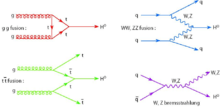
ATLAS investigates many different types of physics that might become detectable in the energetic collisions of the LHC. Some of these are confirmations or improved measurements of the Standard Model, while many others are possible clues for new physical theories.
One of the most important goals of ATLAS was to investigate a missing piece of the Standard Model, the Higgs boson.[14] The Higgs mechanism, which includes the Higgs boson, gives mass to elementary particles, leading to differences between the weak force and electromagnetism by giving the W and Z bosons mass while leaving the photon massless. On July 4, 2012, ATLAS — together with CMS, its sister experiment at the LHC — reported evidence for the existence of a particle consistent with the Higgs boson at a confidence level of 5 sigma,[2] with a mass around 125 GeV, or 133 times the proton mass. This new "Higgs-like" particle was detected by its decay into two photons and its decay to four leptons. In March 2013, in the light of the updated ATLAS and CMS results, CERN announced that the new particle was indeed a Higgs boson. The experiments were also able to show that the properties of the particle as well as the ways it interacts with other particles were well-matched with those of a Higgs boson, which is expected to have spin 0 and positive parity. Analysis of more properties of the particle and data collected in 2015 and 2016 confirmed this further.[12] In 2013, two of the theoretical physicists who predicted the existence of the Standard Model Higgs boson, Peter Higgs and François Englert were awarded the Nobel Prize in Physics.
The asymmetry between the behavior of matter and antimatter, known as CP violation, is also being investigated.[14] Recent experiments dedicated to measurements of CP violation, such as BaBar and Belle, have not detected sufficient CP violation in the Standard Model to explain the lack of detectable antimatter in the universe. It is possible that new models of physics will introduce additional CP violation, shedding light on this problem. Evidence supporting these models might either be detected directly by the production of new particles, or indirectly by measurements of the properties of B- and D-mesons. LHCb, an LHC experiment dedicated to B-mesons, is likely to be better suited to the latter.[15]
The properties of the top quark, discovered at Fermilab in 1995, have so far only been measured approximately. With much greater energy and greater collision rates, the LHC produces a tremendous number of top quarks, allowing ATLAS to make much more precise measurements of its mass and interactions with other particles.[16] These measurements will provide indirect information on the details of the Standard Model, with the possibility of revealing inconsistencies that point to new physics. Similar precision measurements will be made of other known particles; for example, ATLAS may eventually measure the mass of the W boson twice as accurately as has previously been achieved.
One theory that is the subject of much current research is supersymmetry. Supersymmetry can potentially solve a number of problems in theoretical physics, such as the hierarchy problems within gauge theory, and is present in almost all models of string theory. Models of supersymmetry involve new, highly massive particles. In many cases these decay into high-energy quarks and stable heavy particles that are very unlikely to interact with ordinary matter. The stable particles would escape the detector, leaving as a signal one or more high-energy quark jets and a large amount of "missing" momentum. Other hypothetical massive particles, like those in the Kaluza–Klein theory, might leave a similar signature, but their discovery would certainly indicate that there was some kind of physics beyond the Standard Model.
Microscopic black holes
Some hypotheses, based on the ADD model, involve large extra dimensions and predict that micro black holes could be formed by the LHC.[17] These would decay immediately by means of Hawking radiation, producing all particles in the Standard Model in equal numbers and leaving an unequivocal signature in the ATLAS detector.[18]
Components
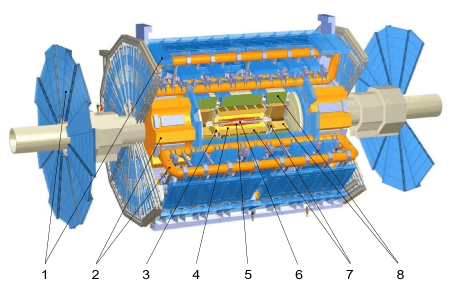
(1)Muon Detectors
Magnet system:
(2) Toroid Magnets
(3) Solenoid Magnet
Inner Detector:
(4) Transition Radiation Tracker
(5) Semi-Conductor Tracker
(6) Pixel Detector
Calorimeters:
(7) Liquid Argon Calorimeter
(8) Tile Calorimeter
The ATLAS detector consists of a series of ever-larger concentric cylinders around the interaction point where the proton beams from the LHC collide. It can be divided into four major parts: the Inner Detector, the calorimeters, the Muon Spectrometer and the magnet systems.[19] Each of these is in turn made of multiple layers. The detectors are complementary: the Inner Detector tracks particles precisely, the calorimeters measure the energy of easily stopped particles, and the muon system makes additional measurements of highly penetrating muons. The two magnet systems bend charged particles in the Inner Detector and the Muon Spectrometer, allowing their momenta to be measured.
The only established stable particles that cannot be detected directly are neutrinos; their presence is inferred by measuring a momentum imbalance among detected particles. For this to work, the detector must be "hermetic", meaning it must detect all non-neutrinos produced, with no blind spots. Maintaining detector performance in the high radiation areas immediately surrounding the proton beams is a significant engineering challenge.
Inner Detector
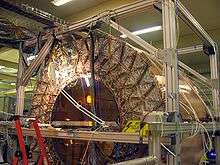
The Inner Detector[21] begins a few centimetres from the proton beam axis, extends to a radius of 1.2 metres, and is 6.2 metres in length along the beam pipe. Its basic function is to track charged particles by detecting their interaction with material at discrete points, revealing detailed information about the types of particles and their momentum.[22] The magnetic field surrounding the entire inner detector causes charged particles to curve; the direction of the curve reveals a particle's charge and the degree of curvature reveals its momentum. The starting points of the tracks yield useful information for identifying particles; for example, if a group of tracks seem to originate from a point other than the original proton–proton collision, this may be a sign that the particles came from the decay of a hadron with a bottom quark (see b-tagging). The Inner Detector has three parts, which are explained below.
The Pixel Detector,[23] the innermost part of the detector, contains three concentric layers and three disks on each end-cap, with a total of 1,744 modules, each measuring 2 centimetres by 6 centimetres. The detecting material is 250 µm thick silicon. Each module contains 16 readout chips and other electronic components. The smallest unit that can be read out is a pixel (50 by 400 micrometres); there are roughly 47,000 pixels per module. The minute pixel size is designed for extremely precise tracking very close to the interaction point. In total, the Pixel Detector has over 80 million readout channels, which is about 50% of the total readout channels of the whole experiment. Having such a large count created a considerable design and engineering challenge. Another challenge was the radiation to which the Pixel Detector is exposed because of its proximity to the interaction point, requiring that all components be radiation hardened in order to continue operating after significant exposures.
The Semi-Conductor Tracker (SCT) is the middle component of the inner detector. It is similar in concept and function to the Pixel Detector but with long, narrow strips rather than small pixels, making coverage of a larger area practical. Each strip measures 80 micrometres by 12 centimetres. The SCT is the most critical part of the inner detector for basic tracking in the plane perpendicular to the beam, since it measures particles over a much larger area than the Pixel Detector, with more sampled points and roughly equal (albeit one-dimensional) accuracy. It is composed of four double layers of silicon strips, and has 6.3 million readout channels and a total area of 61 square meters.
The Transition Radiation Tracker (TRT), the outermost component of the inner detector, is a combination of a straw tracker and a transition radiation detector. The detecting elements are drift tubes (straws), each four millimetres in diameter and up to 144 centimetres long. The uncertainty of track position measurements (position resolution) is about 200 micrometres. This is not as precise as those for the other two detectors, but it was necessary to reduce the cost of covering a larger volume and to have transition radiation detection capability. Each straw is filled with gas that becomes ionized when a charged particle passes through. The straws are held at about −1,500 V, driving the negative ions to a fine wire down the centre of each straw, producing a current pulse (signal) in the wire. The wires with signals create a pattern of 'hit' straws that allow the path of the particle to be determined. Between the straws, materials with widely varying indices of refraction cause ultra-relativistic charged particles to produce transition radiation and leave much stronger signals in some straws. Xenon and argon gas is used to increase the number of straws with strong signals. Since the amount of transition radiation is greatest for highly relativistic particles (those with a speed very near the speed of light), and because particles of a particular energy have a higher speed the lighter they are, particle paths with many very strong signals can be identified as belonging to the lightest charged particles: electrons and their antiparticles, positrons. The TRT has about 298,000 straws in total.
Calorimeters


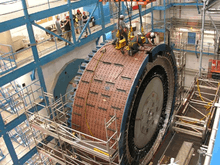
The calorimeters are situated outside the solenoidal magnet that surrounds the Inner Detector. Their purpose is to measure the energy from particles by absorbing it. There are two basic calorimeter systems: an inner electromagnetic calorimeter and an outer hadronic calorimeter.[24] Both are sampling calorimeters; that is, they absorb energy in high-density metal and periodically sample the shape of the resulting particle shower, inferring the energy of the original particle from this measurement.
The electromagnetic (EM) calorimeter absorbs energy from particles that interact electromagnetically, which include charged particles and photons. It has high precision, both in the amount of energy absorbed and in the precise location of the energy deposited. The angle between the particle's trajectory and the detector's beam axis (or more precisely the pseudorapidity) and its angle within the perpendicular plane are both measured to within roughly 0.025 radians. The barrel EM calorimeter has accordion shaped electrodes and the energy-absorbing materials are lead and stainless steel, with liquid argon as the sampling material, and a cryostat is required around the EM calorimeter to keep it sufficiently cool.
The hadron calorimeter absorbs energy from particles that pass through the EM calorimeter, but do interact via the strong force; these particles are primarily hadrons. It is less precise, both in energy magnitude and in the localization (within about 0.1 radians only).[15] The energy-absorbing material is steel, with scintillating tiles that sample the energy deposited. Many of the features of the calorimeter are chosen for their cost-effectiveness; the instrument is large and comprises a huge amount of construction material: the main part of the calorimeter – the tile calorimeter – is 8 metres in diameter and covers 12 metres along the beam axis. The far-forward sections of the hadronic calorimeter are contained within the forward EM calorimeter's cryostat, and use liquid argon as well, while copper and tungsten are used as absorbers.
Muon Spectrometer
The Muon Spectrometer is an extremely large tracking system, consisting of three parts: (1) a magnetic field provided by three toroidal magnets, (2) a set of 1200 chambers measuring with high spatial precision the tracks of the outgoing muons, (3) a set of triggering chambers with accurate time-resolution. The extent of this sub-detector starts at a radius of 4.25 m close to the calorimeters out to the full radius of the detector (11 m).[19] Its tremendous size is required to accurately measure the momentum of muons, which first go through all the other elements of the detector before reaching the muon spectrometer. It was designed to measure, standalone, the momentum of 100 GeV muons with 3% accuracy and of 1 TeV muons with 10% accuracy. It was vital to go to the lengths of putting together such a large piece of equipment because a number of interesting physical processes can only be observed if one or more muons are detected, and because the total energy of particles in an event could not be measured if the muons were ignored. It functions similarly to the Inner Detector, with muons curving so that their momentum can be measured, albeit with a different magnetic field configuration, lower spatial precision, and a much larger volume. It also serves the function of simply identifying muons – very few particles of other types are expected to pass through the calorimeters and subsequently leave signals in the Muon Spectrometer. It has roughly one million readout channels, and its layers of detectors have a total area of 12,000 square meters.
Magnet system
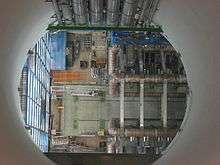
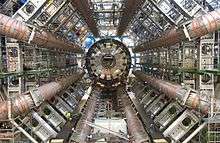
The ATLAS detector uses two large superconducting magnet systems to bend charged particles so that their momenta can be measured. This bending is due to the Lorentz force, which is proportional to velocity. Since all particles produced in the LHC's proton collisions are traveling at very close to the speed of light, the force on particles of different momenta is equal. (In the theory of relativity, momentum is not linear proportional to velocity at such speeds.) Thus high-momentum particles curve very little, while low-momentum particles curve significantly; the amount of curvature can be quantified and the particle momentum can be determined from this value.
The inner solenoid produces a two tesla magnetic field surrounding the Inner Detector.[25] This high magnetic field allows even very energetic particles to curve enough for their momentum to be determined, and its nearly uniform direction and strength allow measurements to be made very precisely. Particles with momenta below roughly 400 MeV will be curved so strongly that they will loop repeatedly in the field and most likely not be measured; however, this energy is very small compared to the several TeV of energy released in each proton collision.
The outer toroidal magnetic field is produced by eight very large air-core superconducting barrel loops and two end-caps air toroidal magnets, all situated outside the calorimeters and within the muon system.[25] This magnetic field extends in an area 26 metres long and 20 metres in diameter, and it stores 1.6 gigajoules of energy. Its magnetic field is not uniform, because a solenoid magnet of sufficient size would be prohibitively expensive to build. It varies between 2 and 8 Teslameters.
Detector performance
The installation of all the above detectors was finished in August 2008. The detectors collected millions of cosmic rays during the magnet repairs which took place between fall 2008 and fall 2009, prior to the first proton collisions. The detector operated with close to 100% efficiency and provided performance characteristics very close to its design values.[26]
Forward detectors
The ATLAS detector is complemented by a set of detectors in the very forward region. These detectors are located in the LHC tunnel far away from the interaction point. The basic idea is to measure elastic scattering at very small angles in order to produce better measurements of the absolute luminosity at the ATLAS interaction point.
Data systems and analysis
The detector generates unmanageably large amounts of raw data: about 25 megabytes per event (raw; zero suppression reduces this to 1.6 MB), multiplied by 40 million beam crossings per second in the center of the detector. This produces a total of 1 petabyte of raw data per second.[27] The trigger system[28] uses simple information to identify, in real time, the most interesting events to retain for detailed analysis. There are three trigger levels. The first is based in electronics on the detector while the other two run primarily on a large computer cluster near the detector. The first-level trigger selects about 100,000 events per second. After the third-level trigger has been applied, a few hundred events remain to be stored for further analysis. This amount of data still requires over 100 megabytes of disk space per second – at least a petabyte each year.[29]
Earlier particle detector read-out and event detection systems were based on parallel shared buses such as VMEbus or FASTBUS. Since such a bus architecture cannot keep up with the data requirements of the LHC experiments, all data acquisition system proposals rely on high-speed point-to-point links and switching networks. People designing the LHC experiments evaluated several such networks, including Asynchronous Transfer Mode, Scalable Coherent Interface, Fibre Channel, Ethernet, and IEEE 1355 (SpaceWire).[30]
Offline event reconstruction is performed on all permanently stored events, turning the pattern of signals from the detector into physics objects, such as jets, photons, and leptons. Grid computing is being extensively used for event reconstruction, allowing the parallel use of university and laboratory computer networks throughout the world for the CPU-intensive task of reducing large quantities of raw data into a form suitable for physics analysis. The software for these tasks has been under development for many years, and will continue to be refined even now that the experiment is collecting data.
Individuals and groups within the collaboration are writing their own code to perform further analysis of these objects, searching the patterns of detected particles for particular physical models or hypothetical particles.
References
- ↑ Aad, G.; (ATLAS Collaboration); et al. (2008). "The ATLAS Experiment at the CERN Large Hadron Collider" (PDF). Journal of Instrumentation. 3 (8): S08003. Bibcode:2008JInst...3S8003A. doi:10.1088/1748-0221/3/08/S08003.
- 1 2 "CERN experiments observe particle consistent with long-sought Higgs boson". CERN. 4 July 2012. Retrieved 2016-11-23.
- ↑ "CERN and the Higgs boson". CERN. Retrieved 23 November 2016.
- ↑ "{title}". Archived from the original on 2014-04-07. Retrieved 2014-04-01.
- ↑ "What is ATLAS?". ATLAS. Archived from the original on 2013-10-12. Retrieved 2013-10-27.
- ↑ https://www.higgstools.org/node/583
- ↑ "ATLAS Collaboration records". CERN Archive. Retrieved 2007-02-25.
- ↑ "First beam and first events in ATLAS". Atlas.ch. 2008-09-10. Retrieved 2016-08-16.
- ↑ "Eight Things To Know As The Large Hadron Collider Breaks Energy Records".
- ↑ "ATLAS Completes First Year at 13 TeV" Archived 2016-01-17 at the Wayback Machine..
- ↑ "ATLAS Begins Recording Physics Data at 13 TeV" Archived 2016-03-05 at the Wayback Machine..
- 1 2 "ATLAS and CMS experiments shed light on Higgs properties". Retrieved 2016-11-23.
- ↑ "World's largest superconducting magnet switches on" (Press release). CERN. 2006-11-20. Retrieved 2016-11-23.
- 1 2 "Introduction and Overview". ATLAS Technical Proposal. CERN. 1994.
- 1 2 N. V. Krasnikov; V. A. Matveev (September 1997). "Physics at LHC". Physics of Particles and Nuclei. 28 (5): 441–470. arXiv:hep-ph/9703204. Bibcode:1997PPN....28..441K. doi:10.1134/1.953049.
- ↑ "Top-Quark Physics". ATLAS Technical Proposal. CERN. 1994.
- ↑ C.M. Harris; M.J. Palmer; M.A. Parker; P. Richardson; A. Sabetfakhri; B.R. Webber (2005). "Exploring higher dimensional black holes at the Large Hadron Collider". Journal of High Energy Physics. 5 (5): 053. arXiv:hep-ph/0411022. Bibcode:2005JHEP...05..053H. doi:10.1088/1126-6708/2005/05/053.
- ↑ J. Tanaka; T. Yamamura; S. Asai; J. Kanzaki (2005). "Study of Black Holes with the ATLAS detector at the LHC". European Physical Journal C. 41 (s2): 19–33. arXiv:hep-ph/0411095. Bibcode:2005EPJC...41...19T. doi:10.1140/epjcd/s2005-02-008-x.
- 1 2 "Overall detector concept". ATLAS Technical Proposal. CERN. 1994.
- ↑ F. Pastore (2010). "Readiness of the ATLAS detector: Performance with the first beam and cosmic data". Nuclear Instruments and Methods in Physics Research Section A. 617 (1/3): 48. Bibcode:2010NIMPA.617...48P. doi:10.1016/j.nima.2009.08.068.
- ↑ Regina Moles-Valls (2010). "Alignment of the ATLAS inner detector tracking system". Nuclear Instruments and Methods in Physics Research Section A. 617 (1–3): 568–570. Bibcode:2010NIMPA.617..568M. doi:10.1016/j.nima.2009.09.101.
- ↑ "Inner detector". ATLAS Technical Proposal. CERN. 1994.
- ↑ Hugging, F. (2006). "The ATLAS pixel detector". IEEE Transactions on Nuclear Science. 53 (6): 1732. arXiv:physics/0412138. Bibcode:2006ITNS...53.1732H. doi:10.1109/TNS.2006.871506.
- ↑ "Calorimetry". ATLAS Technical Proposal. CERN. 1994.
- 1 2 "Magnet system". ATLAS Technical Proposal. CERN. 1994.
- ↑ Aad, G.; (ATLAS Collaboration); et al. (2010). "Performance of the ATLAS Detector using First Collision Data". JHEP. 1009 (9): 056. arXiv:1005.5254. Bibcode:2010JHEP...09..056A. doi:10.1007/JHEP09(2010)056.
- ↑ "Detector Description". Archived from the original on 2011-06-14. Retrieved 2010-11-19.
- ↑ D.A. Scannicchio (2010). "ATLAS Trigger and Data Acquisition: Capabilities and commissioning". Nuclear Instruments and Methods in Physics Research Section A. 617 (1/3): 306. Bibcode:2010NIMPA.617..306S. doi:10.1016/j.nima.2009.06.114.
- ↑ "The sensitive giant". United States Department of Energy Research News. March 2004.
- ↑ Stefan Haas. "The IEEE 1355 Standard: Developments, Performance and Application in High Energy Physics". 1998. p. 1.
Further reading
- ATLAS Technical Proposal. CERN: The Atlas Experiment. Retrieved on 2007-04-10
- ATLAS Detector and Physics Performance Technical Design Report. CERN: The Atlas Experiment. Retrieved on 2007-04-10
- N. V. Krasnikov; V. A. Matveev (September 1997). "Physics at LHC". Physics of Particles and Nuclei. 28 (5): 441–470. arXiv:hep-ph/9703204. Bibcode:1997PPN....28..441K. doi:10.1134/1.953049.
- The Atlas Experiment Monica Lynn Dunford and Peter Jenni, Scholarpedia 9(10):32147. doi:10.4249/scholarpedia.32147
External links
| Wikimedia Commons has media related to ATLAS experiment. |
- Official ATLAS Public Webpage at CERN (The "award winning ATLAS movie" is a very good general introduction!)
- Official ATLAS Collaboration Webpage at CERN (Lots of technical and logistical information)
- ATLAS Cavern Webcams
- Time lapse video of the assembly
- ATLAS section from US/LHC Website
- New York Times article on LHC and experiments
- United States Department of Energy article on ATLAS
- Large Hadron Collider Project Director Dr Lyn Evans CBE on the engineering behind the ATLAS experiment, Ingenia magazine, June 2008
- The ATLAS Collaboration, G Aad; et al. (2008-08-14). "The ATLAS Experiment at the CERN Large Hadron Collider". Journal of Instrumentation. 3 (S08003): S08003. Bibcode:2008JInst...3S8003T. doi:10.1088/1748-0221/3/08/S08003. Retrieved 2008-08-26. (Full design documentation)
- LEGO model of ATLAS, by an ATLAS-scientist at the Niels Bohr Institute
- Padilla, Antonio (Tony). "ATLAS at the Large Hadron Collider". Sixty Symbols. Brady Haran for the University of Nottingham.